Travels with Grace: Final Days in Mexico
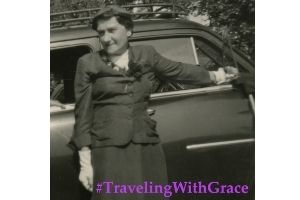
This week’s entry for our 2019 #TravelTuesday series: Traveling with Grace, continues her trip through Mexico. To read more of Grace’s travels, click here.
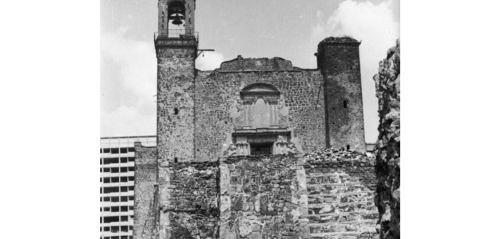
Sun. July 28. This morning (thanks to a man we met in the museum) we had a great treat. At 9 o’clock we went to Santa Maria Iglesia Santiago Tlatelolco where every July 28th is celebrated an all-day fiesta. The parishioners – mostly Indians – dress in traditional costumes with feather headdress, long hair, carry knives and other primitive weapons, beat on tom-toms and shake gourds filled with buckshot. Some wear grotesque masked, others play weird looking and sounding instruments. They dance rhythmically keeping perfect time to the music. Some look quite old but are still agile and graceful. The children join in learning from their elders, some on droll costumes and masks also. One of the young braves did the most remarkable toe dancing I have ever seen. When one group stops, another starts. This takes place on a sort of broad terrace at the side of the church itself which is handsomely decorated with flowers inside and out. Now and then sky rockets are shot into the air which explode with a deafening roar. But it seems a sheer waste to shoot them off in the daytime when only a puff of white smoke can be seen. This celebration is of a purely religious nature though its significance is lost on us. But when some of the visitors tried to take photos they got very excited and would not let them.
From here we went to the Charros Club on Ejército Nacional to see a typical rodeo. This takes place every Sun. morning in an arena which is a miniature of the bull ring. It is a most colorful crowd. In the center sit the senoritas in their beautiful embroidered China Poblano costumes. The Charros wear braided suits, wide silver belts, sombreros of felt of straw decorated with elaborate embroidery and often silver ornaments besides, with straps under their chins. They give a fine display of horsemanship (their mounts are exquisite and saddles and bridles of tooled and silver inlaid leather and heavy silver spurs) and they lasso young colts and twirl long ropes in Will Roger-style. Every now and then a platform is laid down on the ring and one of the Charros dances with a pretty senorita. We saw the dance in which they tie a knot in a scarf with their feet while dancing and another where they dance on the brim of a sombrero. During all this food and drinks are dispensed to the audience (these people are always hungry and thirsty it seems). At one o’clock it is over, and we returned to the Maria Cristina for lunch after which we took our departure for San Jose Perua.

We have to go thru Toluca and a few smaller towns not before visited. The ride is beautiful as are all the rides in this country, tortuous roads with a new and more enchanting view after every curve. When we reached San Jose about 6 it was the most unexpected view which suddenly met our gaze. A turn in the road and there lay a most amazing hotel in the cup of the hills as tho it were carved out of a deep quarry. It is built in a circular pattern spiraling up the slopes, all white and red in its green setting. Tonight they served a buffet supper like they used to have on the ocean liners only more so with every known variety of hors d’oeuvre.
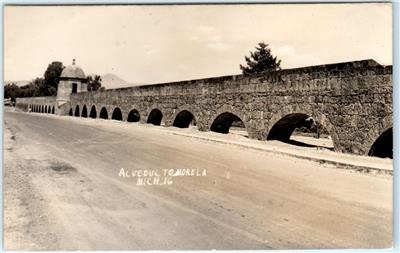
Mon. July 29. This morning it looks even more beautiful here than it did last night. I am sitting out on the little balcony (each room has its own) facing the mts. which appear quite close and directly opposite is a water-fall which reminds me of the Bow Falls at Banff Springs, in fact the setting is very similar but with the difference that the vegetation is tropical. This afternoon we rode to Morelia capital of Michoacán, a beautiful ride over the mts. As you enter the town there is a fine old viaduct, which so often form a sort of boundary line to these old cities. There is a quaint fountain formed by 3 women in colored (majolica like) terra cotta in a kneeling position and forming a circle with their arms upraised to hold a huge platter of various fruits, on top of which are electric lights. We went into the Alameda, a very nice up-to-date hostelry, saw the university, library, cathedral, museum, and the home of Morello for whom the town is named. There are many picturesque courtyards or patios to be glimpsed through the heavy carved wooden doors, slightly ajar and the architecture and lovely iron grill-work are distinctly Spanish. Back at the San Jose Purua we enjoyed a bountiful dinner (the cuisine here is noted throughout Mexico).
Tues. July 30. This morning at the hotel I met Rabbi Clark from Pine Bluff, Ark. who knows Rabbi Coblenz[??] and he introduced me to the hotel’s chef, a very jovial man, a refugee from Vienna, with whom I conversed a little in German. At 10 we started for Mexico City arriving there about 1, took a last look at its beautiful wide avenues, monuments, parks, public buildings and regretfully turned our backs on this fine metropolis with its nearly perfect climate and continued on to Zimapan. This country looks rather bleak and barren after what we have seen in the last few weeks. Arrived in Zimapan a little after 4. Tonight is beautiful and balmy with a young moon and many stars in the sky (they look so close) and after dinner we walked around the courtyard and talked to some of the natives. We have 2 rooms and bath in a sort of auto court.
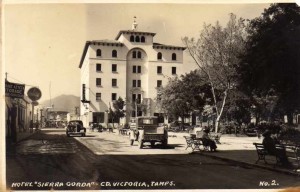
Wed. July 31. Left Zimapan at 9:40. A long last trip to Victoria. Stopped at Tamazunchale and El Mante for gas. Saw the usual groups of natives selling things along the road, fruits, pictures, buts of crystal, leather belts of cow hide and alligator. Arrived at the Sierra Gorda Hotel at 5:45. Outside the hotel they were selling something new tonight, varicolored string hammocks. They carry the most amazing loads on their backs. When we ate in the dining room at the Maria Cristina they used to stand outside the door and display their wares, one minute the flower vender, then the man with feather brushes, all sizes and lengths of handles, then a man with little carved wood trays and boxes, another with bright rugs, blankets, jackets and shawls, another with pottery, another with laces and linens and so on.
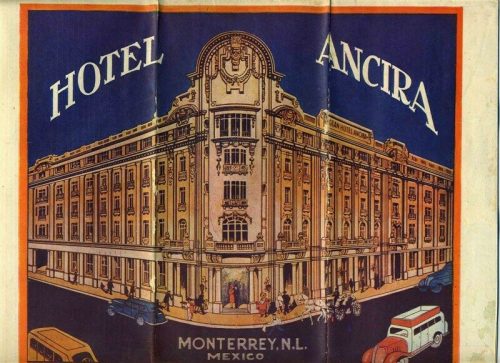
Thurs. Aug. 1. Left Victoria at 10:50. It was very hot but we ran into a shower on the way which cooled us off. Yesterday we went thru the banana belt (and bought them on the road) today we’re in the orange belt and likewise bought some to eat on the way. The country thru which we came today looks much richer and the homes more prosperous than those we saw yesterday. Arrived in Monterey at 1:30 and after getting our room at the Gran Ancira we rode around the city and went to Sanborn’s for dinner, not as big as the one in Mexico City but very attractive and the waitresses wear the same uniforms of striped cotton long skirts, white blouses, fringed shoulder capes in different colors, and headdress to match the skirts. After dinner we looked around their shop where they sell different Mexican novelties and I bought an inexpensive luncheon set. Then we walked around the block and looked in all the shops which are interesting because they are so different from ours.
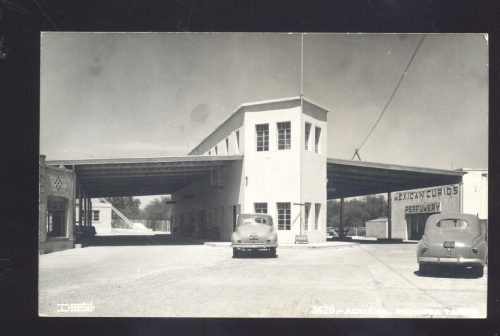
Fri. Aug. 2. Left Monterey at 9:15. The ride to Reynosa was flat and uninteresting thru dry and rather barren country. This border town is small and not nearly as busy and exciting as was Laredo. The American Customs officers took our oranges out of our Sanborn lunch boxes (I had eaten 2 tho before they came) but they didn’t find our cactus pears which Milton had picked on the way. We got thru the customs quicker than on our way down and the minute we were over the border we noticed a sudden and remarkable change in everything. The land was richer, the orange groves irrigated, the houses of [frame??] but much neater and cleaner, no cattle wandering across the roads which are wider and faster. At Pharr, Tex. We put 10 cents in a slot machine and got a big thick sealed paper bag filled with crushed ice for our tea which had gotten warm and we enjoyed our lunch of sandwiches, eggs, potato salad, cactus pears, pickles, and delicious cake, eaten at the side of the road. We passed many orange groves and cotton fields, palm and oleander trees and rode thru a number of small towns including Premont and Kingsville (there is an Alice and a Ben[?] Bolt in this section) and arrived at the Robert Driscoll – a very large, modern and beautiful hotel – in Corpus Christi at 5:45. Tonight we listened to some beautiful music played by a lady entertainer (from 8 to 10:30) on the clavivox, a combination organ and piano (elec!).
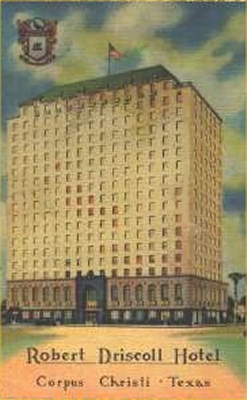
Sat. Aug. 3. Sat in the hotel lobby all afternoon reading and almost froze from the air conditioning. On the street it was like a furnace. But after dark we took a nice ride along the waterfront. It is quite a bathing resort. Lots of hotels, courts, amusement parks, speed boating etc.

Sun. Aug. 4. Left Corpus Christi about 10, stopped for lunch at Bay City at Walgreen’s drug store and arrived at Galveston at 3. The roads are wonderful, many live oaks hung with Spanish moss, lots of palms, deep pink oleanders, crepe myrtles, cotton fields, etc. The approach to the city is thru a very pretty residential section. All the streets in Texan cities seem to be very wide and clean. We are stopping at the Jack Tar Motor Hotel. The dining room is like a mad house. After dinner we went out on the beach, then rode around to see the bright lights, a regular midway.
Came thru the Acadian and Evangeline country full of swamps and bayous. They say this is good for trapping country. Furs are their #1 industry, including mink, squirrel, rabbit, raccoon, possum and skunk.
Thanks for reading “Traveling with Grace,” a series where we’re sharing (and annotating) posts from the travel diaries of Grace Amelia Hecht, native Baltimorean, b. 1897 and d. 1955. As mentioned in my introductory post transcription errors sometimes occur and I’ve made my best guesses where possible, denoted by [brackets]. – Rachel Kassman, marketing manager
